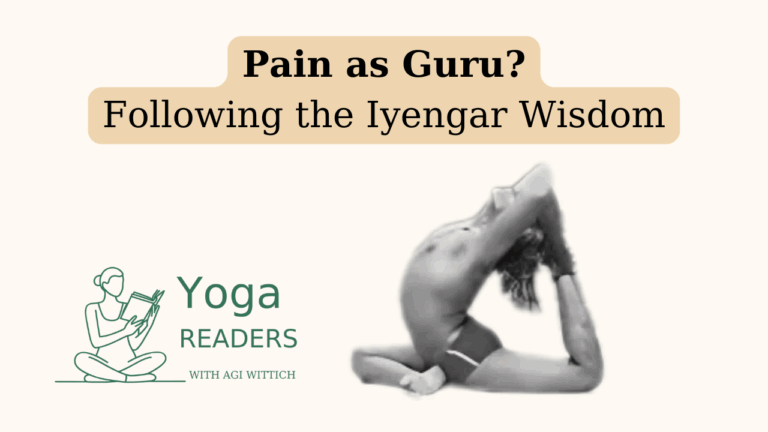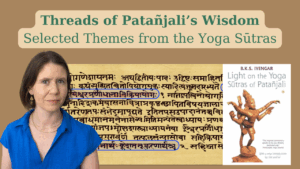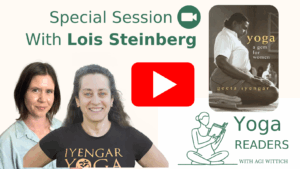
“Pain is your guru.” — B.K.S. Iyengar, Light on Life
This bold teaching from B.K.S. Iyengar often provokes discomfort—not just because it involves pain, but because it asks us to reconsider our relationship with difficulty altogether. What if pain—whether physical, emotional, or mental—was not something to escape from, but a teacher pointing toward deeper awareness?
This is not a glorification of suffering. It is a radical reorientation of attention. In the Iyengar method, pain is not a punishment to endure, nor a mistake to avoid at all costs. It is a signal, a doorway, a moment that demands discernment.
When approached with sensitivity and viveka (discriminative intelligence), pain becomes a valuable mirror. It reveals the hidden tensions, imbalances, and patterns that unconscious movement masks. In this sense, pain can serve as a guru—a bringer of light.
In Light on Life, Guruji writes:
“Right pain is not only constructive but also exhilarating and involves challenge, while wrong pain is destructive and causes excruciating suffering.”
This distinction is not merely semantic. It is foundational. In our daily practice, we are invited to develop the clarity to differentiate between:
This viveka is not given—it is cultivated. It arises through disciplined attention, honest observation, and repeated experience.
Geeta S. Iyengar offers clear direction in Yoga: A Gem for Women:
“If the ache persists, stop the āsanas which cause pain and do simpler ones from the same section.”
This is not weakness—it is wisdom. Geetaji reminds us that adaptation is not compromise. When we modify intelligently, we honor the condition of the body-mind. We learn to work with what is, not what we wish it were. And we remember that yoga is not about overriding the body but listening to it with increasing depth.
In this light, pain teaches boundaries, balance, and appropriate action—skills essential for both the practitioner and the human being.
Iyengar Yoga is steeped in the guru-śiṣya (teacher-student) tradition. A true guru does not merely offer praise—they offer tools, correction, and challenge. The guru does not remove the obstacle—they guide us toward it, with the tools to meet it.
Guruji’s own experience of hardship shaped his precise and demanding teaching style. He writes:
“When I began yoga, there was, I am sorry to say, no wise, kind teacher to lead me… My strictness has really been a passion for precision so that my students should not suffer from the mistakes and hardship I had to endure.”
Yet Guruji also knew that external instruction has its limits. The final teacher—the most enduring one—is internal. This teacher emerges through svādhyāya (self-study), through repeated confrontation with the unknown, through reflection and inner dialogue.
The pain that arises in a sustained backbend, the resistance felt in the groins in Supta Baddha Konasana, the restlessness in Pranayama—each is an opportunity to consult the inner guide:
When the outer guru’s voice is silent, the inner voice must rise. And with practice, it becomes more trustworthy.
Read more about The Sacred Bond: Guru-Śiṣya Tradition Through Geeta Iyengar’s Eyes. And watch my academic lecture about Knowledge and Teaching in the Guru-Śiṣya Tradition.
Pain is not only muscular. The deeper work of yoga involves facing the klesas—ignorance, ego, attachment, aversion, and fear. As Guruji teaches:
“Often people think that sitting quietly is meditation. This is a misunderstanding.”
We are asked to go beyond passivity. Yoga is not withdrawal—it is engagement with clarity. We meet our emotional and mental reactivity with the same honesty we bring to our hamstrings and spines. The pain of heartbreak, disappointment, or fear—these, too, are teachers.
In The Tree of Yoga, Guruji writes:
“Many intellectually developed people are still emotionally immature. If they have to face pain, they try to escape from it.”
In contrast, the yogic path teaches resilience:
Geetaji points us to prānāyāma as a tool to support this transformation:
“Prānāyāma calms the nervous system and brings equipoise.”
This state of samatva—evenness—is not the result of escaping challenge, but of passing through it with skill.
Every obstacle—antarāya—is also an invitation. A plateau in practice may reveal unconscious habit. A minor injury may teach us to refine alignment. A rejection or failure may point to a hidden attachment. Pain sharpens perception, if we are willing to face it.
This is not a call to glorify endurance, but to cultivate appropriate response—what Guruji called movement with intelligence.
“Sometimes the most intelligent action is to stop, adapt, or change direction.” — Geeta S. Iyengar
The pose may be abandoned, but the practice continues. The attitude is what defines the practitioner, not the ability to “do” any particular pose.
In the Iyengar tradition, inner alchemy is not theoretical. It is forged in the body, the breath, and the citta. Difficulty becomes the heat that transforms inertia into clarity.
If you’d like to support my work, you can Buy Me a Chai – and help keep these teachings flowing freely.

A course of selected themes from the Yoga Sutras with Dr. Agi Wittich The Yoga Sūtras of Patañjali are the philosophical heart of yoga.

In a recent Yoga Readers session, Dr. Lois Steinberg opened her teaching archives and personal memories, sharing stories that span four decades of study
Agi Wittich is a yoga practitioner since two decades, and is a certified Iyengar Yoga teacher. Wittich studied Sanskrit and Tamil at the Hebrew University of Jerusalem, Israel, completing a PhD with a focus on Hinduism, Yoga, and Gender. She has published academic papers exploring topics such as Iyengar yoga and women, the effects of Western media on the image of yoga, and an analysis of the Thirumanthiram yoga text.